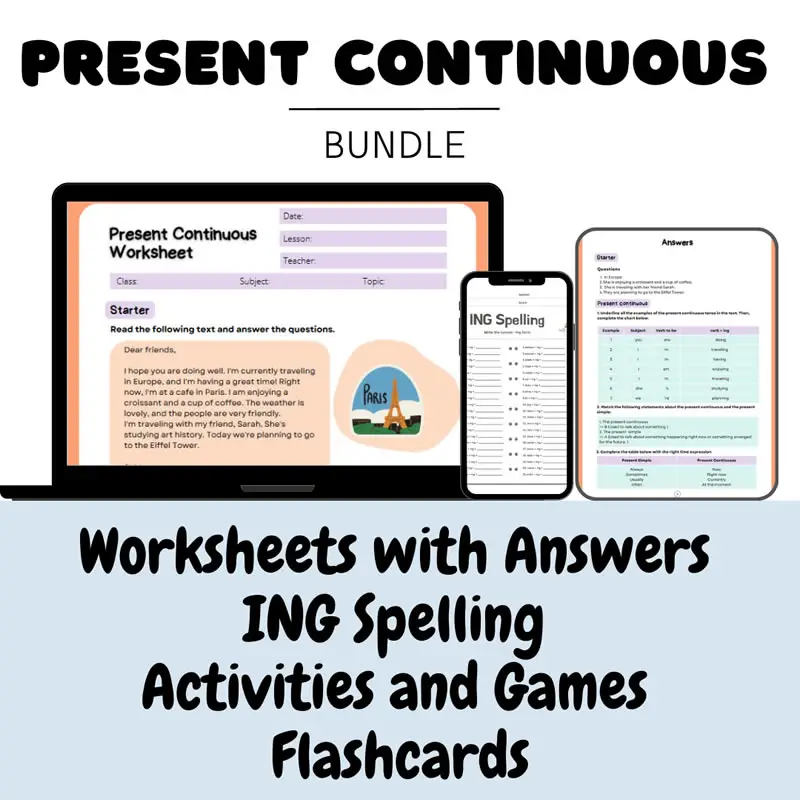Teaching the present continuous tense after teaching the simple present can be confusing for students. It might not be easy for them to distinguish between the use of the simple present for habits and routines and the use of the present continuous for actions happening at the time of speaking (or for future arrangement.)
Table of Contents
This post provides an easy-to-implement lesson plan to introduce the present continuous tense using a discovery approach.
We will start with a text where instances of the target language are used.
After a meaning-focused activity, whose aim is to make sure that the students have understood the text, we will raise their awareness about the form and use of the present continuous. We will encourage them to underline the verbs and complete a chart.
Then, they will have to distinguish between the simple present and the present continuous uses.
After that, they will have the opportunity to practice the tense, first, in controlled exercises, and, then, in less controlled tasks.
This lesson plan is part of A Present Continuous Bundle (PDF & PNG format files) on My English Pages Store, which includes, a lesson plan, lesson worksheet, ing-spelling worksheet, flashcards, games and activities, and much more.
GET it here:
Let’s get started!
Teaching the present continuous tense
Let us first provide a context where the examples of the present continuous is used!
1. Start with a context
The best thing you can start with to teach grammar is to contextualize the target structures. A short representative text will do.
With Love From Paris
Dear friends,

I hope you are doing well. I’m currently traveling in Europe, and I’m having a great time! Right now, I’m at a cafe in Paris. I am enjoying a croissant and a cup of coffee. The weather is lovely, and the people are very friendly.
I’m traveling with my friend, Sarah. She’s studying art history. Today we’re planning to go to the Eiffel Tower.
Jane
Ask Students to answer these questions in pairs:
- Where is the author currently?
- What is the author doing right now?
- Whom is the author traveling with?
- What are they planning to do today?
After class correction, it is high time for the grammar lesson!
2. Raise students’ awareness about the target language
This stage aims to draw students’ attention to the present continuous form and use.
Before you proceed, write this sentence on the board:
- Jane is sitting at a café in Paris at the moment.
- She is enjoying a croissant and a cup of coffee
Ask them to figure out the structure of the present continuous:
Subject + Verb To Be + Verb + ING
Then, ask them to underline all the examples of the present continuous tense in the text. Then,
complete the chart below:
| Example | Subject | Verb To Be | Present Participle |
| 1 | |||
| 2 | |||
| 3 | |||
| 4 | |||
| 5 | |||
| 6 | |||
| 7 |
To distinguish between the present simple and present continuous use, invite your students to match the following:
| The present simple is… | A. …used to talk about something happening right now or something arranged for the future. |
| The present continuous is… | B. …used to talk about habits and routines. |
3. Invite Students to practice the target language
Now, after having raised our student’s awareness about the form and use of the present continuous and after contrasting the use of the simple present with that of the present continuous, it is practice time now!
Let us start with controlled exercises. This is perfect for the conscious application of the rules discovered in the previous stage.
We will assign our students three exercises: matching, putting verbs in the correct form, and transforming sentences from present simple to present continuous.
Practice Exercises
Exercise 1: Matching Match the sentence with the correct present continuous form:
| 1. Sarah _____ a book. 2. They _____ Paris. 3. I _____ well. | A. is reading B. are visiting C. am doing |
Exercise 2: Gap Filling Fill in the gaps with the correct present continuous form of the verb in brackets:
- I _____ (study) for my exam at the moment.
- She _____ (watch) TV right now.
- We _____ (not play) football today because it’s raining.
- They _____ (not listen) to music at the moment.
Exercise 3: Transforming Sentences Rewrite the following sentences in the present continuous:
- He always reads history books. -> Now, he _ a book about the Roman empire.
- They usually walk in the park. -> Now, they__ in the park.
- She sometimes sings for friends. ->Now, she __ a new song for her best friend.
4. Encourage students to use the present continuous tense
After practicing the present continuous in controlled exercises, the students are hopefully ready to use this tense in a freer activity.
One way of doing so is by asking students to work in groups to describe pictures of people doing various things.

- In pairs or small groups, ask students to create sentences using the present continuous tense to describe what they or someone else is doing at the moment.
- Monitor their work and provide feedback and correction if necessary.
5. Review and summarize
After the practice activities, it’s important to review and summarize the lesson to reinforce students’ learning and help them remember what they have learned. To do this, you can:
Let groups of students provide a recapitulation of the key points covered in the lesson. Ask them to highlight:
- The present continuous form and use.
- The distinction between the simple present and present continuous.
- Give their own examples
Finally, you can end the session by providing students with feedback on their performance and giving them (homework) suggestions for further practice.
Conclusion
Teaching the present continuous tense to ESL or EFL students can be challenging, but a discovery approach can make it easier for them to understand and use it correctly.
It is essential to start with a short text where the present continuous tense is used and raise the students’ awareness of its form and use. After that, they should practice the tense in controlled exercises, and finally, in a freer activity where they can use the tense in context. By following these steps, students will gain confidence and proficiency in using the present continuous tense in their communication.
By following these steps, students will gain confidence and proficiency in using the present continuous tense in their communication.
As a teacher, it is crucial to afford an environment where they can explicitly explore the target language by providing them with guided activities to discover the form and use of the present continuous.
Get Your Copy Of The Present Continuous Pack
If you’re looking for a more comprehensive way to teach and practice the present continuous tense, you might be interested in our Present Continuous Bundle Product. This bundle includes a range of activities, worksheets, and games that cover all aspects of the present continuous tense, from the basic form to more advanced uses.



